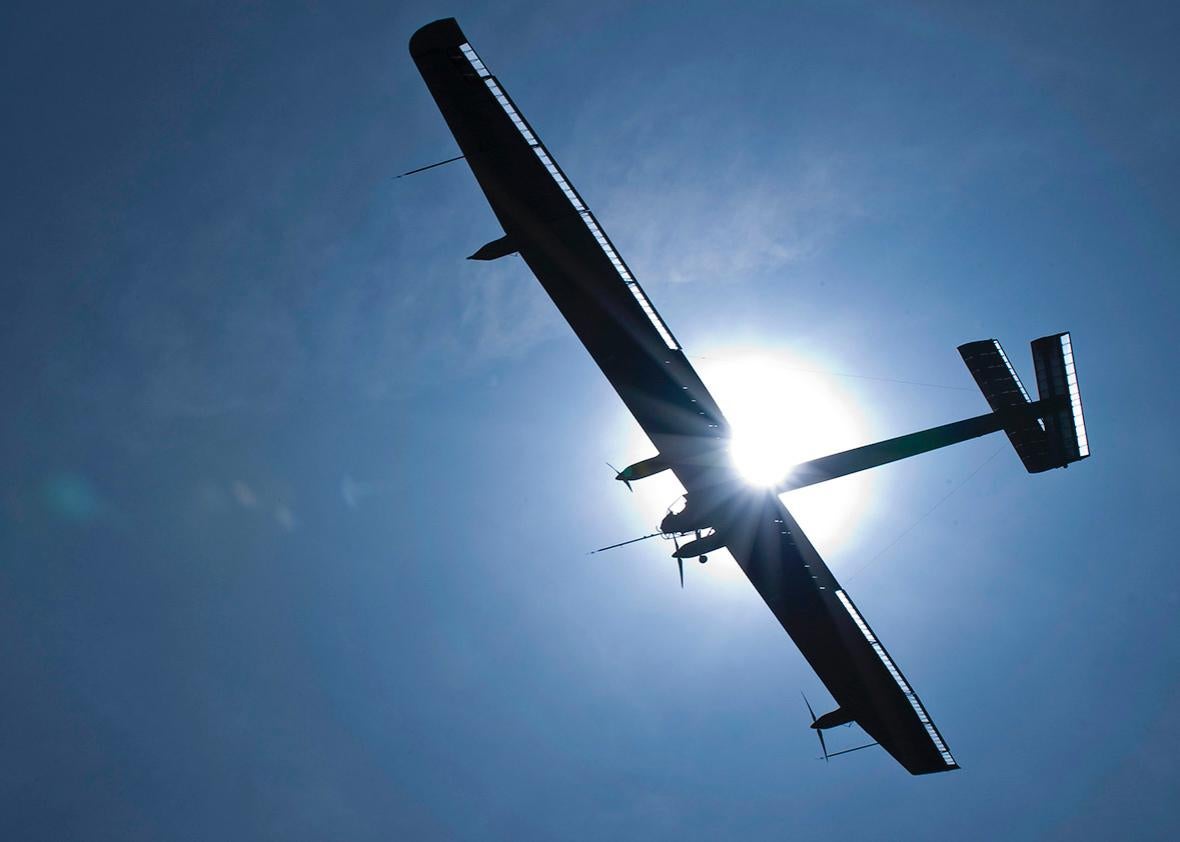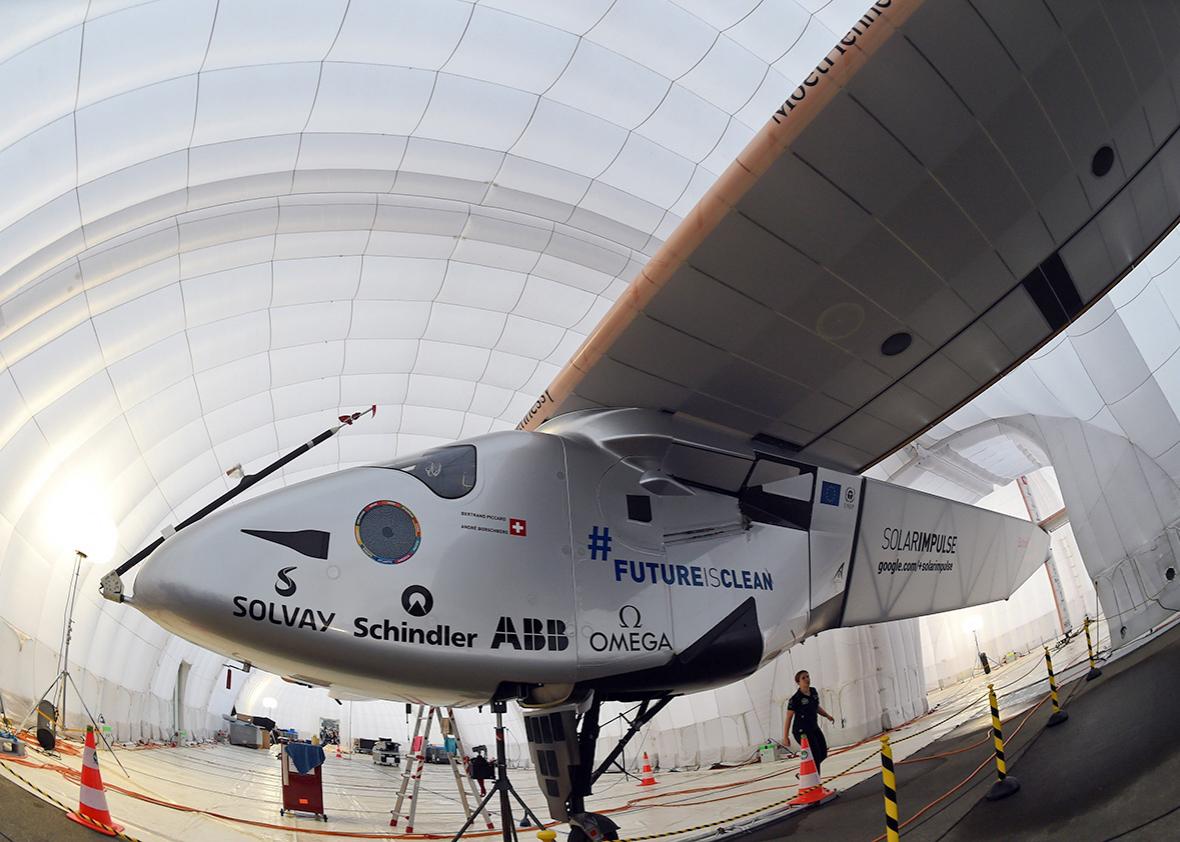There have been a couple of high-profile aviation experiments that involved flying without fuel this summer, ones that might be easily dismissed as stunts. First, the Solar Impulse—which soaks up rays during the day and runs on batteries at night—undertook a harrowing five-day manned flight from Japan to Hawaii. (I was glued to its webcast as pilot André Borschberg flew the wobbly craft over a vast stretch of the Pacific Ocean.) Then in the second week of July, two different planes powered only by batteries flew over the English Channel from Britain to France.
These feats can strike skeptics as futile. When I mentioned to someone in the fossil-fuel business that a plane had just crossed half the Pacific on solar power, the answer came, “Why?” After all, what are these stunts demonstrating? The Solar Impulse went about 40 mph, and its batteries were sufficiently damaged by the journey that the next leg of its trek has been delayed. The Cricri, one of the channel-crossing planes, topped out at about 90 miles per hour. These one- and two-seaters can’t carry a significant number of passengers or any cargo to speak of. Jet fuel is cheap and plentiful—by recent historical standards—and planes that run on it are remarkably fast and safe.
Solar crossings often look more like model-kit demonstrations or science experiments or publicity stunts (the Solar Impulse has a host of high-end brand sponsorships) than serious advances in transportation. And, no, solar panels aren’t going to replace fuel-powered Boeing 787 Dreamliners or Airbus A380s as workhorses of the sky.
But these events are nonetheless important for several reasons. The first is almost purely emotional. There’s something about the concept of human flight that touches a nerve, captures the public’s imagination, and simply gets people excited—from Lindbergh’s Atlantic crossing in 1927 to the Apollo moon landing in 1969, to the guy who in 2012 jumped from a helium balloon 24 miles above the Earth.* Many of us feel a vicarious thrill, and subsequently a sense of inspiration, from watching people take steps for mankind.
The second is more practical. Innovations in transportation almost always strike contemporary observers as useless, dangerous, rickety contraptions that don’t stand a chance of being anything more than curiosities. The loud, belching steamboat Robert Fulton launched on the Hudson River in 1807 was dubbed “Fulton’s Folly” by observers. The Wright Brothers’ first plane (which is now recapturing some of our imaginations thanks to a new biography by David McCullough), didn’t look particularly airworthy as its insubstantial frame wobbled along the North Carolina coastline. Henry Ford’s first cars were clanking, clattering, high-end menaces. When they first appeared, each of these transport modes was a one-off—an expensive home kit produced by hobbyists. And yet each developed over the course of a few decades into a dominant, economically efficient, safe standard.
The same cycle can be seen with both renewable energy and electricity storage—the two phenomena that made the Solar Impulse’s journey possible. Forty years ago, solar panels were toys for hobbyists or off-the-grid hippies. Homespun power was both expensive and inefficient. But a few decades of engineering prowess, manufacturing scale, and innovation can work wonders. Today, solar panels can be arrayed at so-called utility scale—large enough to rival big power plants. And in some parts of the country, solar farms are the low-cost power source. In the 1980s, electric cars were extremely expensive, low-functioning vehicles—glorified golf carts. Today, the Tesla Model S comes with an option that lets the car zoom from zero to 60 mph in 2.8 seconds.

Photo by Laurent Gillieron/Pool via Reuters
This is not to argue that 2015’s solar- and battery-powered Solar Impulse will become 2035’s solar- and battery-powered supersonic passenger jet. But to assume it would misses the point—and the potential impact. As we’ve seen with both the power industry and the auto industry, the greatest near-term potential for changes in the ways we produce, store, and discharge electricity isn’t that they will displace the old modes entirely. Rather, it is that they simultaneously put pressure on incumbents to up their games and create opportunities for the system to assimilate new technologies in ways that benefit consumers and the environment.
Hybrids and electric cars account for about 3 percent of U.S. auto sales in any given month. But the presence of these models—and the technology that makes them possible—has pushed manufacturers of conventional vehicles to work harder on efficiency and to incorporate electrification and batteries into their propulsion systems. Light hybrid systems like Ford’s Ecoboost and General Motors’ eAssist are becoming standard in many models. Overall, the typical car sold in the U.S. today is about 25 percent more fuel-efficient than the typical car sold in the U.S. in 2007, according to the University of Michigan’s Transportation Research Institute. My plug-in Prius isn’t an electric car, but most of the time it drives like one. Since I got it two months ago, I’ve driven about 900 miles while using only eight gallons of gas—about 113 miles per gallon, which is many times better than the Jeep I used to drive.
At the same time, solar and wind haven’t made the U.S. electricity system—which is primarily fueled by coal, natural gas, and nuclear power—obsolete. They have challenged it to adapt. In the first half of this year, according to the Federal Energy Regulatory Commission, 65 percent of the new electric generating capacity built in the U.S. has been renewable, with virtually all the rest powered by natural gas.
I can imagine two ways in which these efforts at emission-free flights could influence the aviation system. First, small aircrafts powered largely by batteries could provide transportation for people and goods who live on islands or in remote areas where rail and road travel don’t make sense and it may be easier and cheaper to produce electricity than to deliver liquid fuel. So we could see them used to shuttle people across the English Channel, or to go island-hopping in the Caribbean, or to deliver mail in Alaska. Fleets of smaller vehicles could also be used for emergency deliveries, especially in rural areas where road systems are lacking—say, in sub-Saharan Africa.
Second, these efforts could spur the aviation industry to think more deeply and seriously about using sources of power other than fuel as part of its existing efforts. Lufthansa is using the TaxiBot, a hybrid-electric tractor that can pull a plane from the gate to the runway while its engines are turned off. Boeing’s planes employ powerful batteries that can power up an aircraft’s systems before the engine turns on. The more such efforts are attempted, the more likely they are to be used at scale.
Put another way, these pioneering efforts at battery-powered flight don’t make it likely that planes will fly solely on electricity in the future. They do make it likely that planes will fly while relying more on electricity in the future. And that represents a giant leap.
Correction, July 24, 2015: This article originally misstated that Felix Baumgartner jumped from a plane 24 miles above the Earth. He jumped from a helium balloon. (Return.)
